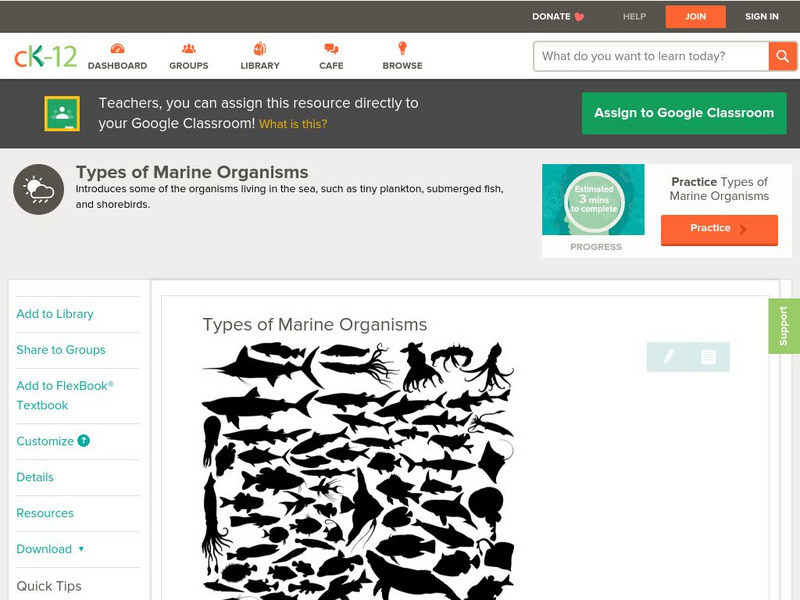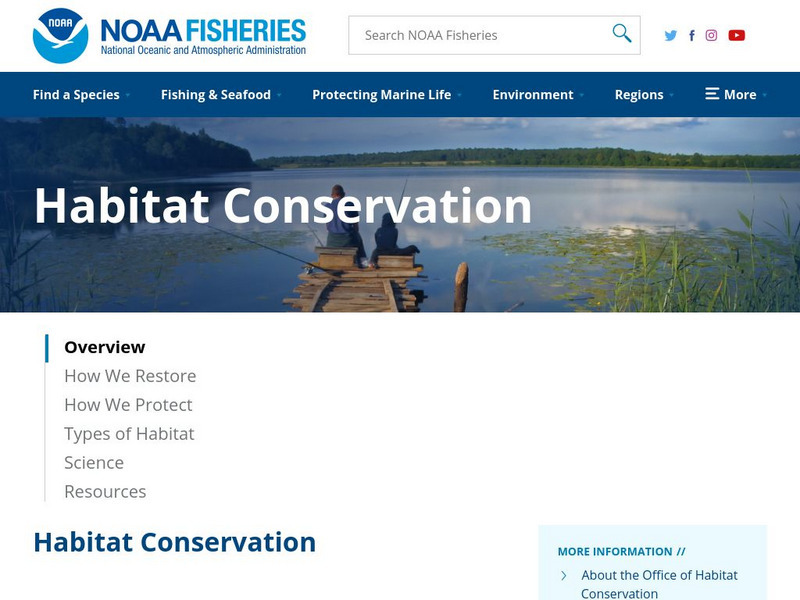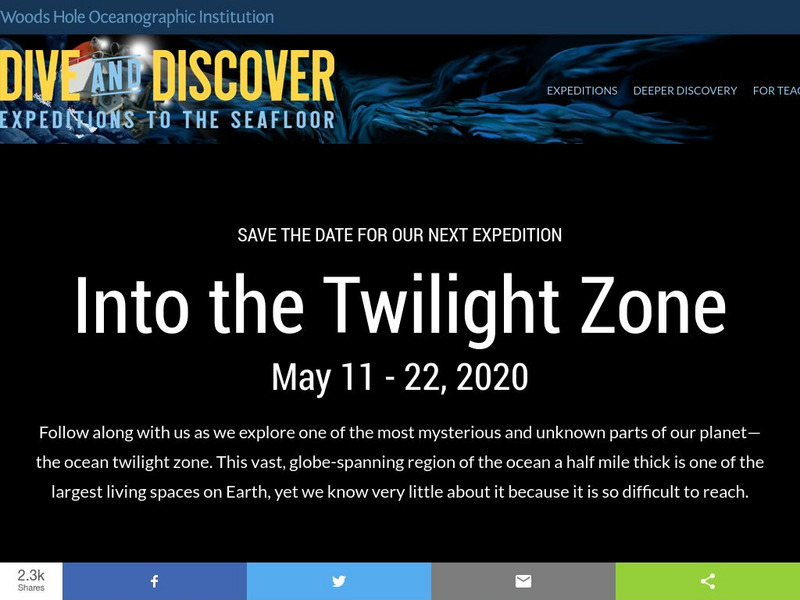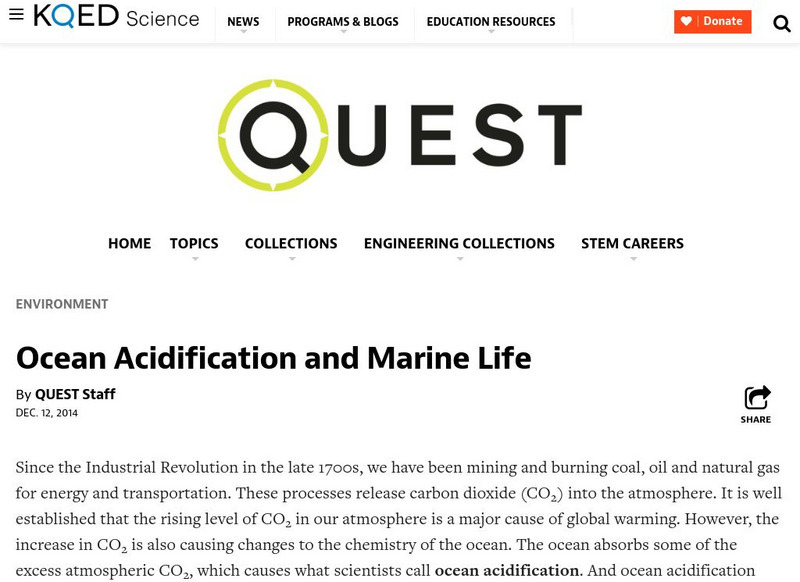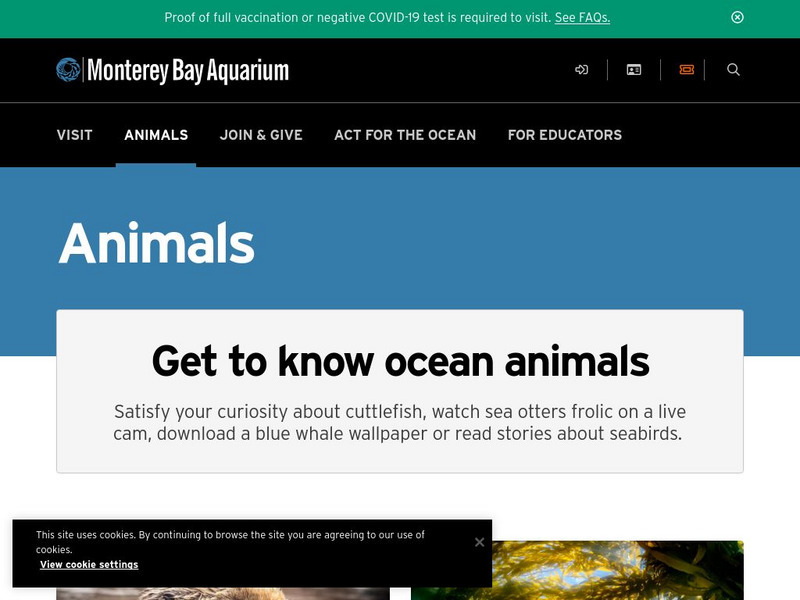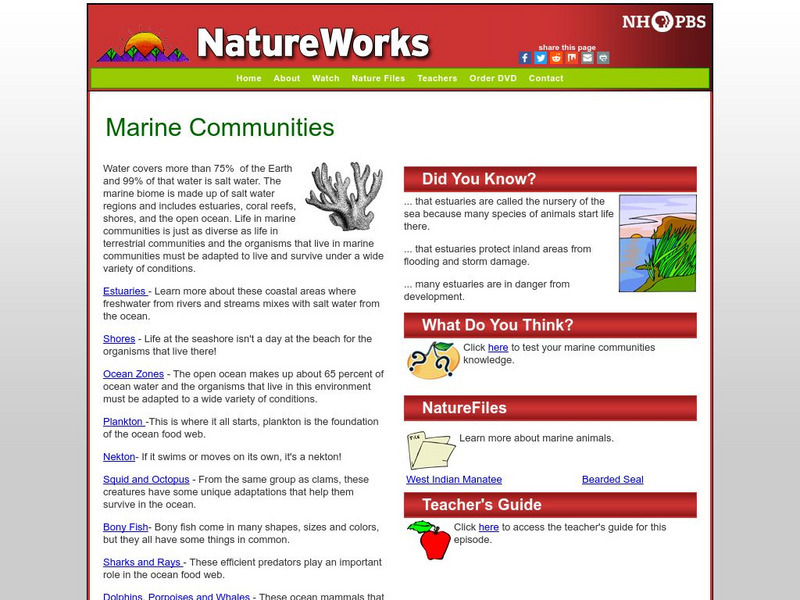CK-12 Foundation
Ck 12: Earth Science: Seafloor
[Free Registration/Login may be required to access all resource tools.] Examines how Earth scientists study the seafloor.
CK-12 Foundation
Ck 12: Earth Science: Types of Marine Organisms
[Free Registration/Login may be required to access all resource tools.] Provides an overview of the organisms living in the sea.
CK-12 Foundation
Ck 12: Earth Science: Types of Marine Organisms
[Free Registration/Login may be required to access all resource tools.] Provides an overview of the organisms living in the sea.
American Museum of Natural History
American Museum of Natural History: It Takes All Kinds to Make a World
Learn about the biodiversity found in the ocean by looking at examples of marine life.
CK-12 Foundation
Ck 12: Earth Science: Deposition by Waves
[Free Registration/Login may be required to access all resource tools.] Describes terrain features formed by ocean waves.
CK-12 Foundation
Ck 12: Life Science: Aquatic Biomes
[Free Registration/Login may be required to access all resource tools.] Aquatic biomes can be generally classified based on the amount of salt in the water. Freshwater biomes have less than 1% salt and are typical of ponds and lakes,...
NOAA
Noaa: Fisheries Office of Habitat Conservation
NOAA Fisheries Office of Habitat Conservation oversees the conservation of United States coastal and marine habitats. Learn about the different projects they have undertaken and supported, what the work involves, and why it is so...
Sophia Learning
Sophia: Oceans
An audio podcast highlighting the numerous marine ecosystems in the oceans. [1:50]
Woods Hole Oceanographic Institution
Woods Hole Oceanographic Institute: Dive and Discover: Expeditions to Sea Floor
Join Woods Hole scientists as they search for new volcanic eruptions on the ridge system in the eastern Pacific.
PBS
Quest: How Ocean Acidification Affects Shelled Organisms
This step-by-step tutorial walks students through the effects of ocean acidification on some shelled marine organisms.
Other
Nasa: From the Top of the World to the Bottom of the Food Web
Teachers and students discover linkages among marine ecology, phytoplankton, the behavior of light at the ocean surface, and satellite-derived ocean color data. Explore the topics of phytoplankton, food webs, and algal blooms using...
American Museum of Natural History
American Museum of Natural History: O Logy: What's the Big Idea? Marine Biology
An introduction to key concepts about the ocean, its ecosystems, and zones. With interactive flash cards that open in new windows to help you learn more.
Other
Cisa: The Impact on Drought on Coastal Ecosystems in the Carolinas [Pdf]
This State of Knowledge Report provides a synthesis and analysis of the peer-reviewed literature regarding drought impacts on coastal ecosystems in the Carolinas. Its objective is to expand current, limited understanding of drought...
Nature Conservancy
Nature Conservancy: Planet Earth: Oceans and Coasts
Compilation of the Nature Conservancy's content about the ecology of oceans and coasts. Emphasis is on the biodiversity of these habitats and the human impact on the animal and plant life that live in our oceans and on our coasts.
Other
Project Wild: Aquatic Times [Pdf]
Teach students to be more aware of issues surrounding aquatic animals and their habitats. Includes lesson, extension activities, and evaluation ideas.
Science Struck
Science Struck: A Helpful Guide to Understand the Photic Zone
The photic zone is the upper layer of the ocean where sunlight can penetrate and support photosynthesis. This article explains the characteristics of this zone, the food chain that exists there, the adaptations of the plants and animals,...
Huntington Library
Huntington Library: Mini Ecosystems [Pdf]
A lesson activity where students create a terrarium inside a plastic bottle using a Venus Flytrap and other plants. They then observe growth and changes over time.
Science Struck
Science Struck: Facts About the Marine Biome
Describes the characteristics of the marine biome, the plants and animals that live in each of the four ocean zones, coral reefs and estuaries, the climate of the marine biome, and the marine food web.
Monterey Bay Aquarium
Monterey Bay Aquarium: Animal Guide
An extensive image-rich field guide to marine habitats and inhabitants, with detailed descriptions and "cool facts" about each.
BiologyWise
Biology Wise: Marine Biology Facts
Discusses the unique characteristics of the oceans and the many organisms that live in a marine ecosystem.
PBS
Nh Pbs: Nature Works: Marine Communities
Explore saltwater ecosystems around Earth. Learn about oceans, estuaries, shores, and more.
CK-12 Foundation
Ck 12: Earth Science: Types of Marine Organisms Study Guide
[Free Registration/Login may be required to access all resource tools.] This study guide summarizes key points about the types of organisms found in marine environments. Includes a few questions to check for understanding.



